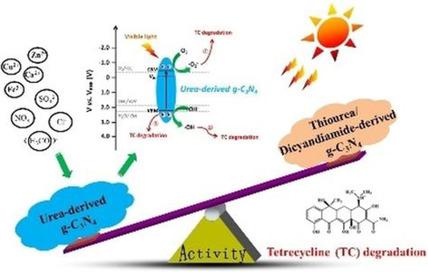当前位置:
X-MOL 学术
›
Chem. Asian J.
›
论文详情
Our official English website, www.x-mol.net, welcomes your
feedback! (Note: you will need to create a separate account there.)
Cost‐Efficient Graphitic Carbon Nitride as an Effective Photocatalyst for Antibiotic Degradation: An Insight into the Effects of Different Precursors and Coexisting Ions, and Photocatalytic Mechanism
Chemistry - An Asian Journal ( IF 3.5 ) Pub Date : 2018-12-04 , DOI: 10.1002/asia.201801416 Cheng Tian 1 , Hui Zhao 1 , Jian Mei 1 , Shijian Yang 1
Chemistry - An Asian Journal ( IF 3.5 ) Pub Date : 2018-12-04 , DOI: 10.1002/asia.201801416 Cheng Tian 1 , Hui Zhao 1 , Jian Mei 1 , Shijian Yang 1
Affiliation

|
In this study, the photocatalytic activity of graphitic carbon nitride (g‐C3N4) synthesized via different precursors (urea, thiourea, and dicyandiamide) is investigated in the degradation process of tetracycline. Owing to the efficient charge separation and transfer, prolonged radiative lifetime of charge, large surface area, and nanosheet morphology, the urea‐derived g‐C3N4 exhibits superior photocatalytic activity for tetracycline degradation under visible‐light irradiation. This performance can compare with that of most reported g‐C3N4‐based composite photocatalysts. Through the time‐circle degradation experiment, the urea‐derived g‐C3N4 is found to have an excellent photocatalytic stability. The presence of NO3−, CH3COO−, Cl− and SO42− ions with the concentration of 10 mm inhibits the photocatalytic activity of urea‐derived g‐C3N4, where this inhibitory effect is more obvious for Cl− and SO42− ions. For the coexisting Cu2+, Ca2+, and Zn2+ ions, the Cu2+ ion exhibits a significantly higher inhibitory effect than Ca2+ and Zn2+ ions for tetracycline degradation. However, both the inhibitory and facilitating effects are observed in the presence of Fe3+ ion with different concentration. The h+, .OH and .O2− radicals are confirmed as major oxidation species and a possible photocatalytic mechanism is proposed in a urea‐derived g‐C3N4 reaction system. This study is of important significance to promote the large‐scale application of g‐C3N4 photocatalysts in antibiotic wastewater purification.
中文翻译:

具有成本效益的石墨碳氮化物作为一种有效的抗生素降解光催化剂:深入了解不同前体和共存离子的作用以及光催化机理
在这项研究中,研究了在四环素的降解过程中,通过不同的前体(脲,硫脲和双氰胺)合成的石墨氮化碳(g-C 3 N 4)的光催化活性。由于有效的电荷分离和转移,延长的电荷辐射寿命,较大的表面积以及纳米片的形态,尿素衍生的g-C 3 N 4对可见光照射下的四环素降解具有优异的光催化活性。该性能可以与大多数报道的基于gC 3 N 4的复合光催化剂进行比较。通过时间循环降解实验,尿素衍生的g‐C 3 N 4被发现具有优异的光催化稳定性。NO的存在3 -,CH 3 COO - ,氯-和SO 4根2-离子为10 m的浓度米抑制尿素衍生的G-C的光催化活性3 Ñ 4,其中该抑制作用是更明显氯-和SO 4 2-离子。对于共存的Cu 2 +,Ca 2+和Zn 2+离子,Cu 2+离子显示出比Ca 2+和Zn 2+显着更高的抑制作用。离子降解四环素。但是,在存在不同浓度的Fe 3+离子的情况下,观察到了抑制作用和促进作用。为H +,。OH和。ö 2 -基团被确认为主要氧化物质和光催化可能机制是在尿素衍生的G-C提议3 Ñ 4反应体系中。这项研究对于促进g‐C 3 N 4光催化剂在抗生素废水净化中的大规模应用具有重要意义。
更新日期:2018-12-04
中文翻译:

具有成本效益的石墨碳氮化物作为一种有效的抗生素降解光催化剂:深入了解不同前体和共存离子的作用以及光催化机理
在这项研究中,研究了在四环素的降解过程中,通过不同的前体(脲,硫脲和双氰胺)合成的石墨氮化碳(g-C 3 N 4)的光催化活性。由于有效的电荷分离和转移,延长的电荷辐射寿命,较大的表面积以及纳米片的形态,尿素衍生的g-C 3 N 4对可见光照射下的四环素降解具有优异的光催化活性。该性能可以与大多数报道的基于gC 3 N 4的复合光催化剂进行比较。通过时间循环降解实验,尿素衍生的g‐C 3 N 4被发现具有优异的光催化稳定性。NO的存在3 -,CH 3 COO - ,氯-和SO 4根2-离子为10 m的浓度米抑制尿素衍生的G-C的光催化活性3 Ñ 4,其中该抑制作用是更明显氯-和SO 4 2-离子。对于共存的Cu 2 +,Ca 2+和Zn 2+离子,Cu 2+离子显示出比Ca 2+和Zn 2+显着更高的抑制作用。离子降解四环素。但是,在存在不同浓度的Fe 3+离子的情况下,观察到了抑制作用和促进作用。为H +,。OH和。ö 2 -基团被确认为主要氧化物质和光催化可能机制是在尿素衍生的G-C提议3 Ñ 4反应体系中。这项研究对于促进g‐C 3 N 4光催化剂在抗生素废水净化中的大规模应用具有重要意义。











































 京公网安备 11010802027423号
京公网安备 11010802027423号